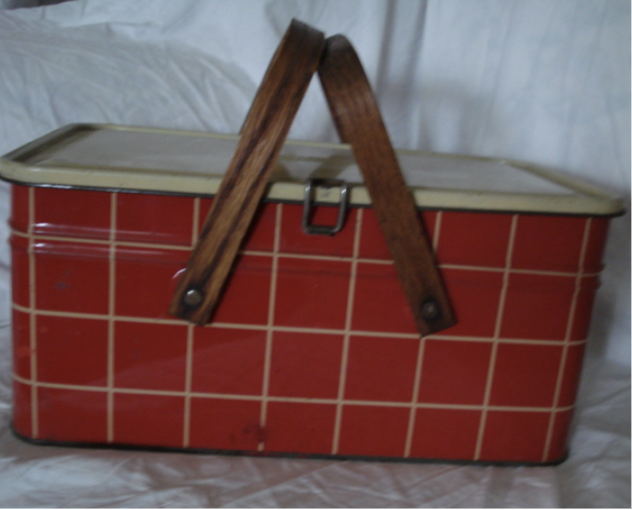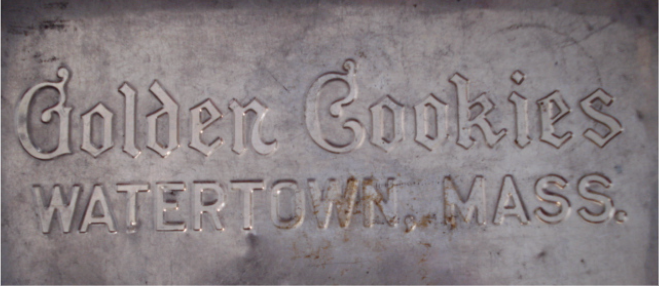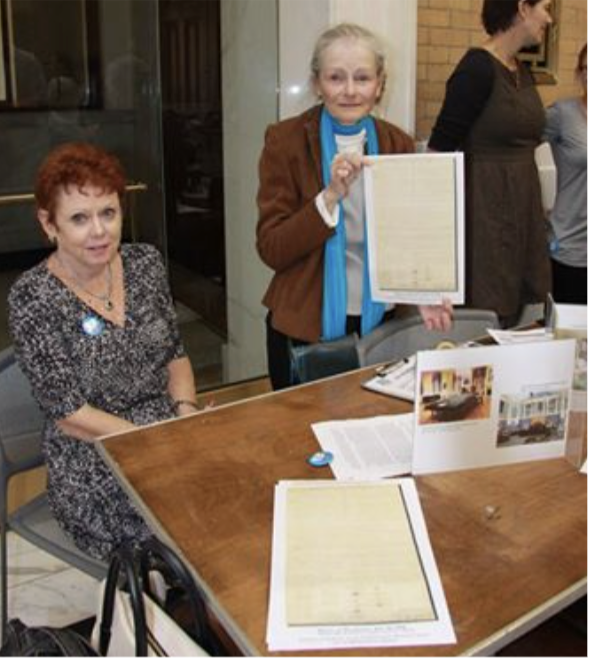
The following story is part of a series on local history provided by the Historical Society of Watertown. It was written by Sigrid Reddy Watson Terman for the July 2005 Historical Society of Watertown newsletter, “The Town Crier.” Sigrid is a former Board member and former President of the Historical Society, as well at a former Director of the Watertown Free Public Library.
For several years starting in 1997, she wrote a Watertown history column for the Watertown TAB/Press called “Echoes.” Sigrid published her columns in a book called “Watertown Echoes: A Look Back at Life in a Massachusetts Town”. The book is available for purchase through the Historical Society of Watertown for $10. To purchase it, please contact Joyce at joycekel@aol.com.
The building now occupied by Boston Biomedical Research Institute, at 64 Grove Street in East Watertown (Editor’s 2023 note – this building is no longer occupied by BBRI), typifies the transition from a 20th-century building’s original use to a new and apparently unrelated one. People with long memories have told me how they used to buy bags of broken cookies at the Golden Cookie Company for a few cents during the Depression of the 1920s and 30s, and even into the 50s. Their memories, however, may not be long enough to remember the actual purpose
for which the building was originally intended.
In a conversation with Rob Greer, whose great-grandfather, J.W.Greer, founded the company where cookies were baked, I discovered that it was actually the manufacture of equipment for wrapping penny candies that first motivated him. J.W.Greer began as the owner of a general store in Texas. Rob said that in the country at that time – about the turn of the 20th century – many store owners made candy in their back rooms. J.W. invented a wrapping device for the sticky candy that was an improvement over the hand method used by many shopkeepers. He sold his machine to an outfit that employed him to sell his invention, and eventually he ended up in Cambridge, which Rob noted was, after all, “the candy manufacturing center of the country.”
Soon J.W. became involved in improving methods not only of improving candy-wrapping machines, but also of enrobing chocolates. The liquid chocolate was poured over the candy centers, with the residue dripping through a wire mesh screen. After the product was cooled, the excess chocolate covering could be reheated and used for the next batch. It soon occurred to J.W. that a moving wire mesh conveyor belt would be more efficient than stationary trays, and that the process would work as well for baking cookies and crackers, which had to be placed by hand on large sheets that were carried on shelves through an oven on a vertical reel device resembling a Ferris wheel. Loading and unloading these ovens, Rob commented, was a hot and exhausting job. The process, J.W. figured, could be simpler and less labor-intensive if the products could be moved horizontally by means of a continuous steel belt traveling through a long tunnel-like oven, where also the temperature could be more easily controlled.
J.W. attempted to persuade the National Biscuit Company to try out his method, but they were not convinced that it would work. Undaunted, he decided to build his own plant, having acquired several acres on a railroad line just over the Cambridge border. His son Fred drew up the plans for a single-story building 60 feet wide and 300 feet long to accommodate the equipment his father had designed: dough mixers, cookie-forming machines, and the unique “band” oven.
The special steel belt, or “band,” was imported from Sweden, the equipment was installed, and the demonstration was begun. Cookies and crackers, Rob Greer said, were discharged directly from their forming machines onto the oven conveyer belt and proceeded through the baking chamber at a speed of from 15 to 20 feet per minute, baking for from 7 to 10 minutes, depending on the timing required by the product. Heat was provided from several oil burners. When the cookies or crackers emerged from the oven, they were stripped off and cooled on wire mesh racks.
The cookies produced in the demonstration of this technological marvel were at first donated to local charitable organizations; soon, however, the Greer family, all of whom were involved in the production, realized that they could no longer afford to give away thousands of pounds of cookies every week, and thus the Golden Cookie Company was born. As production increased, Fred designed and had built, in the factory’s machine shop, a 180-degree turntable that carried the cookies around the end and ran them along another cooling conveyor going in the opposite direction along the length of the building (Fred later obtained a patent on this device.)

The company’s products were so successful that the Greers opened their own store and sold their cookies and crackers directly to the public. They sold the broken cookies to local children, even purposely breaking them, Rob Greer told me, when they had more cookies than they needed for sale. Eventually Kresge and Woolworth stores began buying golden Cookies and the overproduction problem was solved. Rob also said that the Golden Cookie factory may very well have been the very first bakery where Girl Scout cookies were produced. His mother, he said, received an award from the Girl Scouts for 60 years of service to the organization.
With the objective of selling his conveyer-belt baking system, J.W. now approached the National Biscuit Company and the Sunshine Bakery and offered them free use of his facilities so that they could try out their own recipes with their own personnel. Amazed at the more efficient and cost-effective process, NBC and Sunshine had Greer ovens and belts built in their own plants in New York. Independent bakers, having seen what Greer products could do, also became customers of the company’s ovens, belts, and coating machines. If you visit any baking operation where a product goes through the oven on a mesh belt, you are probably seeing a Greer belt, especially, as Rob says, if it needs “breading” and “battering.” Having heard about the famous Krispy Kreme doughnuts, I persuaded my family, on a trip in Texas, to stop for a sampling, and there we saw the conveyor belt carrying the doughnuts through the oven, being coated and sprinkled as they traveled.
This success story ended with a tragic twist, for in 1936, having weathered the worst of the Depression, the successful bakery operation engendered complaints from some of the company’s equipment customers, who alleged that the Greers were engaging in unfair competition. In 1937 the employees – the same people who had been employed by the family during the Depression – went out on strike, demanding a 33% wage increase and a closed union shop. Embittered by what they considered the ingratitude of the employees with whom they had worked side by side packing cookies, the Greers sold the company to two of the managers, who continued operation of the business for several years, eventually selling it for over a million dollars.
In mid-January of 1999 the Boston Biomedical Research Institute, which had been looking for larger quarters, purchased the cookie factory building for 17 million dollars. The building, disused for many years, underwent 16 months of renovation to provide more space for the scientists and the installation for them of modern laboratory facilities. In 2000 the Institute moved from its old quarters at 28 Staniford Street, Boston, into its new state-of-the-art building at 64 Grove Street in Watertown. By designing an open-lab layout and shared facilities, the building provided space for continued growth. Henry Paulus, the deputy director who chaired the search committee, is extremely pleased with the Institute’s new home. In addition, his new policy is to reach out to the Watertown community by organizing a series of lectures (including one on local history) and art exhibitions, to which he invites interested guests from the Boston area and especially welcomes Watertown residents. In the old cookie factory building we can now see the evolution of 20th-century technology into 21st-century scientific research.
From our July 2015 newsletter –
SOCIETY LOANS ARTIFACT TO STATE HOUSE
A Golden Cookie Factory cookie tin/basket donated to us several years ago by Mary Keenan and her sister Joan Clifford is on loan to and will shortly be on display at the State House in Boston. The Senate President invited each Senator to procure an item from a museum, gallery or historical society that represents their district. The items will be displayed in the locked glass cabinets in Senate Room 428. Senator Brownsberger’s office contacted us asking if we had something we would loan them. It could not be perishable nor more than 18 inches tall.

We chose the cookie tin/basket. The signage will say, “The Golden Cookie Company in Watertown was founded when sample cookies baked to demonstrate J. W. Greer’s metal mesh conveyor belts manufactured for commercial bakeries proved wildly popular. The factory, an important source of employment in Watertown’s East End, is still remembered for its enticing baking smells and for the big twenty-five cent bags of broken cookies.”
From our January 2016 newsletter –
MASSACHUSETTS MUSEUM DAY AT THE STATE HOUSE
On October 7, 2015, the Historical Society of Watertown joined the New England Museum Association (NEMA) for Mass. Museums Day to celebrate the diversity and unique achievements of museums and museum professionals in Massachusetts.
Massachusetts Museums Day brought together the statewide museum community for an afternoon event, featuring speakers, displays from participating museums, conversation with colleagues, and a reception in the State House to meet and mingle with our legislators.

Each museum was eager and proud to share their unique resources and achievements with other museum representatives.
While we were there, we decided to visit Senate Room 428 where the Golden Cookie Factory cookie tin/basket we loaned to the State House is on display. We were escorted to Room 428, a room used for meetings scheduled by the Senate President’s office, usually 50-100 people at a briefing or hearing. The door to the room is locked when not in use and when there is a meeting a court officer is in the room. The glass cases remain locked at all times.

We were very impressed by the stunning meeting room and the beautiful display made up of artifacts from the various Massachusetts museums. Other items on display include a transcript of Bridget Bishop’s 1692 hearing (above our cookie tin) from the Corwin House (aka the Witch House) in Salem and a 19th century woman’s boot from the Lynn Historical Society.) The display is open to the public. The next time you are in Boston, stop at the information desk in State House and ask to see the exhibit cases in Room 428. They will provide an escorted visit. (Editor’s 2023 Note: The display is no longer in the State House.)
That was an interesting story. I always see local folks mentioning the Golden Cookie Factory, which I don’t remember, and I thought it was pretty cool that the owner came up with that way to manufacture cookies.